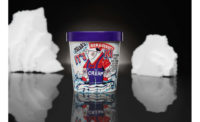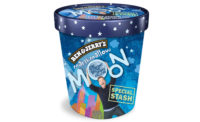In 1978, two guys named Ben Cohen and Jerry Greenfield forked over $5 to take a Penn State correspondence course on ice cream making. They then went on to invest $12,000, $4,000 of it borrowed, to open their first ice cream shop in a former gas station located in Burlington, Vt.
Now, almost 40 years later, there are 577 Ben & Jerry’s Scoop Shops worldwide. And the company’s three U.S. factories churn out pints, in total, at a rate of 400 per minute. The pints are delivered to 38 countries in 50 to 75 available flavors at any given time. Read more about Ben & Jerry's plants.
Although their initial focus was on creating a successful business, Cohen and Greenfield added to that mission along the way. In 1979, after their first year in business, they celebrated with their first Free Cone Day (now celebrated every year), giving away ice cream to the community that supported them. That’s when Cohen determined that “business has the responsibility to give back to the community.”
In 1988, the partners codified the three-part mission statement that still guides Ben & Jerry’s operations today: to make the best products, to be financially successful and to stand up for social causes.
“When you combine these three parts on a horizontal level, you’re basically saying that each decision has to consider all of them,” said Jostein Solheim, CEO of Ben & Jerry’s. “We’re very much an ‘and’ company — ‘Can we do that, and that, and that?’”
Even though it began by bootstrapping, Ben & Jerry’s officially entered the world of big food when Unilever acquired the Burlington-based company in 2001. However, the deal was secured by a caveat: An independent board of directors are to provide leadership, as well as to make sure Ben & Jerry’s stays on point regarding its social mission, brand integrity and product quality.
Today, such value-driven tenets are becoming more commonplace among companies, as exemplified by the recent creation of DanoneWave after Danone acquired WhiteWave. DanoneWave was recently incorporated as the largest public benefit corporation in the United States. However, preserving a large company’s social mission was much less common a decade and a half ago.
Ingredients count, too
“We also have a linked-prosperity business model, which is a pre-cursor to the circular economy, but it directs how we can use our business to create prosperity,” Solheim said. “And we do that by buying values-led ingredients; that’s the biggest investment we make.”
In 2015, Ben & Jerry’s finished its transition to sourcing entirely non-GMO ingredients. But the company has been forward-thinking throughout its history, coming out against recombinant Bovine Growth Hormone (rBGH) in 1989 due to concerns over its impact on family farmers, as well as consumers’ confidence in its products.
In addition, it established the Ben & Jerry’s Foundation in 1985 to fund community-oriented projects. The employee-led grant programs totaled $2.5 million in 2016, supporting economic social justice, environmental restoration and peace.
“We give away more than $2 million through our foundation, but we buy over $100 million-worth of ingredients,” Solheim said. “So if we can make the investment into those ingredients and their communities, that’s the biggest impact we can make.”
Ben & Jerry’s became a certified benefit corporation in 2012 and continues to focus on values-led sourcing. For example, it uses only Fair Trade certified ingredients wherever possible.
Inspired by popular culture
Since Ben & Jerry’s pints hit store shelves across the nation decades ago, consumers have been responding positively to the unique ice cream flavors with comically bizarre names such as Chunky Monkey, Chubby Hubby, and Coffee, Coffee BuzzBuzzBuzz.
“We’re ice cream nerds. We live and breathe ice cream,” Solheim said. “But popular culture is also important for us, and it’s a slightly quirky take on the culture.”
Hence, the slate of music-inspired names such as Cherry Garcia, a play on the Grateful Dead’s iconic lead man Jerry Garcia, and Phish Food, referencing the jam-band Phish. Another recent addition to this category is the Bob Marley’s One Love flavor, which debuted this past summer. A portion of the proceeds from each pint sold benefits Jamaica’s One Love Youth Camp, a program run by The Bob Marley Foundation and Partners for Youth Empowerment.
“We have a rich heritage of being connected to music culture,” said Jay Curley, Ben & Jerry’s senior global marketing manager. “We’re always looking for partners that share values and fan bases seeking shared experiences. And we found that with Bob Marley’s ethos around love and justice. We’re all fans here.”
Dedicated to flavor innovation
 Ben & Jerry’s continues to push the envelope with flavors — and, of course, flavor names. For example, the company introduced three new foodie-centric flavors in 2017: Urban Bourbon, Truffle Kerfuffle and Oat of this Swirled.
Ben & Jerry’s continues to push the envelope with flavors — and, of course, flavor names. For example, the company introduced three new foodie-centric flavors in 2017: Urban Bourbon, Truffle Kerfuffle and Oat of this Swirled.
To continue to delight its customers, Ben & Jerry’s employs “flavor gurus,” who consider and develop daring dessert flavors. On average, it takes the gurus approximately 18 months to take a flavor from concept to the store shelf. Flavor trends, market analysis and boots-on-the-ground research all go into germinating the idea. The idea is then pitched to the marketing team, and ingredients are ordered to develop it.
“We eat and think about ice cream, but we also eat all parallel categories,” Solheim said. “We don’t just think ice cream is for wonderful, indulgent moments; it’s mental and physical replenishment.”
Flavor names can range from literal descriptions such as Chocolate Fudge Brownie to more eccentric names birthed in meetings open to the entire company. Of course, the regulatory paperwork must be filled out and manufacturing specs have to be determined through plant walks to ensure the product can be made consistently.
In the case of the new foodie-centric ice cream flavors, the gurus were channeling recent food trends such as burnt flavors and salted twists on fan favorites, plus a nod at nostalgic eating experiences. Urban Bourbon is a burnt caramel ice cream with almonds, fudge and bourbon caramel swirls, which addresses the big trend in classic cocktails with millennials consuming more spirits.
“Bourbon is a classic flavor trend,” Solheim said. “To help develop these flavors, the team will go into a restaurant and order every single dessert on a menu.”
Truffle Kerfuffle is another variation on a foodie trend — the salty-sweet combination, incorporating roasted pecans, fudge and a salted chocolate ganache swirl into vanilla ice cream.
“This year’s flavors are unique and really more culinary inspired,” Curley said. “And we can’t be Ben & Jerry’s without naming things like Truffle Kerfuffle.”
The Oat of this Swirled flavor, meanwhile, evokes a whimsical feeling through the combined flavors of brown sugar, oatmeal and cinnamon. It’s also a homage to one of the company’s retired flavors, Oatmeal Cookie Chunk, which still draws plenty of fan mail years after being retired.
Also new are “cereal milk” flavors, available only in Ben & Jerry’s Scoop Shops. Cocoa Loco, Frozen Flakes and Frozen Fruities are all inspired by that guilty pleasure of kids drinking the sweetened milk leftover from the cereal bowl. The company calls the limited-availability line “Cereal Splashbacks.”
“We always make sure we can bring you some of that nostalgia that triggers memories,” said Solheim. “When you taste this flavor, it brings you right back to childhood. It’s a very deep emotional experience.”
Respectful of retired flavors
Although Ben & Jerry’s is constantly introducing new flavors, the company never forgets about its out-of-commission pints, cataloging them in “The Flavor Graveyard.” On its website, grieving fans can reminisce and request a comeback for retired flavors such as White Russian, which had its run from 1986-1996, or the lesser-known Holy Cannoli, which was available only from 1997-1998.
“The Flavor Graveyard has two important roles for us,” Solheim said. “The biggest thing that holds the company back is fear, so if you can celebrate failure — ‘Maybe we didn’t do this or that right’ — then that allows us to try more things. The second part is we have over 45 live SKUs on the shelf, and we work on 300-odd flavors all the time, so by definition there isn’t room for every one, and it’s going to rotate around.”
And there is always a chance if a flavor gets enough resurrection votes, it might appear in the supermarket again.
Thinking outside the pint
After years of concentrating on developing new flavors, Ben & Jerry’s took the dairy world by surprise this past February by introducing an ice cream novelty: Pint Slices.
Each slice is a single-serving disc — meant to look like it has been cut from the center of the pint — that is coated in chocolate. The Pint Slices are available in four flavors: Chocolate Fudge Brownie, Chocolate Chip Cookie Dough, Vanilla Peanut Butter Cup and Americone Dream.
“Our re-entry into novelties with the Pint Slices has been great from a business perspective, but also that we’re giving our fans what they want in terms of being able to have Ben & Jerry’s in a different format,” Curley said. “It was time to reinvigorate our bar business and to give the category something a little different.”
The product was created to address consumers’ increasingly on-the-go lifestyle and demand for convenience. Each slice is individually wrapped in an easy open-pouch, which is also designed to double as a mess catcher.
“To have a stick-less bar with a dense, rich, super-premium ice cream and the inclusions, that’s not really something that’s on the market,” Curley said.
Why stick-less? To fit in all the chunks and other add-ins Ben & Jerry’s ice cream traditionally has, the company came up with a secret technology, but couldn’t find room to fit the stick in.
“We knew that people are buying the different novelties, whether it’s for on-the-go or for snacking or for the portion control,” Curley said. “Like anything, we wanted to come at it with a uniquely Ben & Jerry’s product that’s going to set us apart from other products on the shelves in a way that’s true to who we are.”
The Pint Slices are sold in three-count boxes in the novelty section of the ice cream aisle in stores and in Scoop Shops nationwide.
Excited about new dairy alternatives
For Ben & Jerry’s, recent innovations haven’t been limited to cow milk-based dairy products. Last year, the company introduced non-dairy frozen-dessert pint offerings made with almond milk, which the flavor gurus determined was the best blank canvas for all of the specialty add-ins.
“This is one of those places that the latent consumer demand was so high,” Curley said. “We had been working for years to deliver a Ben & Jerry’s non-dairy product that was going to deliver on Ben & Jerry’s standard. We could’ve come out with a non-dairy option, but something that was going to be as rich, as creamy and really deliver on what people expect from Ben & Jerry’s, that took a lot of time and effort.”
The products are also 100% certified vegan, so no eggs, dairy or honey is included in any of the line’s products. All of the brownies, caramel, nuts and chocolate included in the pints are made with non-animal ingredients.
“To have these options available for vegans or lactose-intolerant customers — or even folks that are looking to cut a little dairy out of their diets — it’s great to offer that,” Curley said.
The original non-dairy pint flavors are Chocolate Fudge Brownie, Chunky Monkey, Coffee Caramel Fudge and PB & Cookies. And this past February, Ben & Jerry’s introduced three more flavors. Exclusive to the non-dairy line is Caramel Almond Brittle, which features salted caramel swirls with pieces of almond brittle. The other two flavors newly available in non-dairy are the classic Ben & Jerry’s Cherry Garcia and Coconut Seven Layer Bar.
“We launched the initial flavors, but the demand was huge,” Curley said. “And we really helped grow the [non-dairy] category. Within months we were second in terms of share, and since we’ve entered the category, it’s grown over 70%.”
Solheim said he’s excited by Ben & Jerry’s ability to bring innovation that provides genuine and new experiences to fans.
“Going forward, we’re able to find multiple entry points for people into our categories. I think that’s super exciting,” he said.
Ben & Jerry’s response to glyphosate findings
As consumers demand more transparency from food companies, the granular details of ingredients in food and beverages are being put in the spotlight. Efforts to move companies to non-GMO ingredients have been successful, but the focus now might be shifting to testing foods for chemical residue — specifically for glyphosate, the active ingredient in Roundup and other herbicides.
The topic received some publicity this past summer when an article in The New York Times reported that traces of glyphosate had been found in 10 of 11 samples of Ben & Jerry’s ice cream. However, the levels detected were far below the ceiling set by the U.S. Environmental Protection Agency.
In a formal response to the article, Ben & Jerry’s did say it was concerned to learn of the glyphosate traces found in its flavors. But the company noted that recent studies had found levels 78 times higher in organic whole wheat bread. And in a popular whole grain oat breakfast cereal, levels were 646 times higher.
The original article did point out that a 75-pound child would have to eat 145,000 8-ounce servings per day to reach the limit set by the EPA. Therefore, the Ben & Jerry’s products are safe to eat.
Ben & Jerry’s states that it has had many programs over the years designed to help the agricultural system, including programs to label rBGH, transition to non-GMO ingredients, source Fair Trade ingredients and support sustainability efforts with farmers.
“We’re at an exciting time where we can address some of the challenges of the dairy industry in terms of our carbon footprint and our environmental impact,” said Jostein Solheim, Ben & Jerry’s CEO. “We can find cost-efficient and cost-lowering ways to improve operations, reduce runoff and tighten up on nutrient management.”
Executive photos by Vito Palmisano










